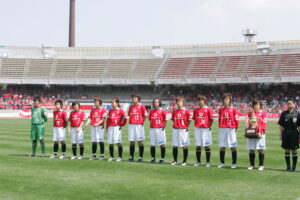“History of the Nadeshiko League” 15. “Intensifying Competition”
From the time when it was still unusual for women to play football, through to the birth of the Japan Women’s Football League, victory in the Women’s World Cup, and creation of the Japan Women’s Empowerment Professional Football League, social conditions and the environment surrounding girls’ and women’s football have undergone great changes.
We intend to publish a series of 22 articles before the end of the year in which we will look back over the tempestuous history of girls’ and women’s football in Japan.

As was described in the fifth installment of this series entitled “Beleza the “Frontrunners””, over 32 seasons of the Japan Women’s Football League (Nadeshiko League) between 1989 and 2020, Tokyo’s Beleza constantly played the leading role in the championship race. Although the official name of Beleza has changed variously over the years from Yomiuri Beleza to Yomiuri Nippon Beleza, Yomiuri Seiyu Beleza, NTV Beleza, and finally Nippon TV Beleza, this team has remained overwhelmingly strong throughout. The history of the Nadeshiko League has been a catalog of challenges to Beleza’s supremacy.
When the League was first established, Suzuyo Shimizu FC emerged and fought for the prestige of “the soccer kingdom Shizuoka”. After that, Nikko Securities (Chiba Prefecture) emerged in the latter part of the 1990s and was followed by TASAKI Perule (Hyogo Prefecture) at the beginning of the 21st century, and these teams sometimes succeeded in taking the title from Beleza (Nikko Securities was the champion for three years in succession). Also during this period, Panasonic Bambina (Osaka Prefecture) and Prima Ham Football Club Kunoichi (Mie Prefecture) made spirited challenges and experienced championship success.
However, following the “crisis” years from 1999 to 2003, new challengers emerged. These were Urawa Reds Ladies (Saitama Prefecture) and INAC Kobe Leonessa (Hyogo Prefecture). The exploits of Urawa Reds Ladies were previously described in part 11 of this series entitled “The Rise of New Powers”. In 2005, management of the hitherto community-based team “Saitama Reinas” was transferred to the J. League powerhouse and highly popular Urawa Reds, which constantly attracted between 40,000 and 50,000 supporters to Saitama Stadium.
Having thus acquired training facilities including multiple pitches at “Reds Land”, which was opened that year, and human resources (operating staff and coaching staff) that had been developed by Urawa Reds from the time of the Japan Football League (1965-1992), Reds Ladies grew steadily. While some of its players were signed to professional contracts, many worked for Urawa Reds’ sponsor companies in Saitama Prefecture and could conduct full training every day in the evening. For women’s football in those days, this was almost an ideal environment.
Although Reds Ladies did not contest the championship every year, it became the league champions in 2009, 2014 and 2020, and the team’s four titles including the one achieved during the Reinas era are second only to the 17 won by Beleza.
In Kansai too, a completely new powerhouse emerged. INAC Leonessa was founded in 2001 based on the determination of INAC Holdings, which was involved in the entertainment, restaurant and sports businesses in Hyogo Prefecture, to build a world-class sports team. INAC, which had the meaning of “International Athletic Club”, was created with aspirations to build an international team from the start.
It was also noteworthy that INAC advocated “professionalization” from the beginning. 2001 was the year in which the Nadeshiko League (then called the L. League) was confronted with a crisis and had to split into the East and West leagues in order to save on costs.
In 2004, INAC won the Kansai Women’s Football League Division 1 title and also appeared in the JFA Japan Women’s Football Championship (Empress’s Cup). In this, after beating Tokiwagi Gakuen High School (Miyagi Prefecture) 3-2 in the first round, it lost to Beleza 1-3 in the second round. However, its efforts earned it enough recognition to be granted promotion to Nadeshiko League 2 in 2005.
INAC did not pass up this opportunity. Having signed two Brazilian players including the national team forward Pretinha on professional contracts, it won the L2 championship in its first year and gained promotion to the top Nadeshiko League five years after its founding. INAC continued to put effort into recruitment and acquired a succession of star players; indeed, seven out of the 21 players that represented Nadeshiko Japan at the 2011 World Cup belonged to INAC. In 2012, Kobe Ladies Football Center, a dedicated training facility, was completed on the reclaimed Rokkoh Island, and INAC grew powerful enough to compete with Beleza.
Beleza, which maintained its policy of focusing energy on youth development, continued to produce players who were good enough to represent Nadeshiko Japan, won the title for four consecutive years from 2005. However, thanks to the emergence of new powers and intensification of competition, the standard of the Nadeshiko League was being raised.
Yoshiyuki Osumi (football journalist)






